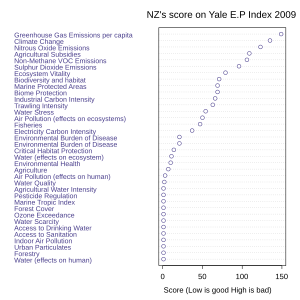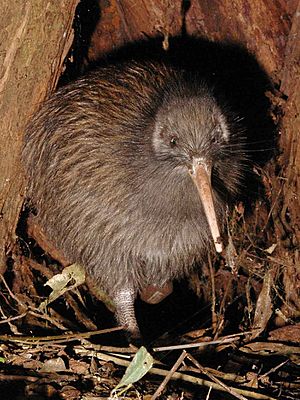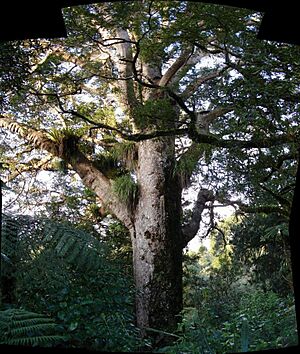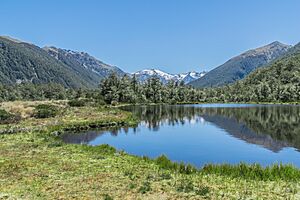Environment of New Zealand facts for kids
New Zealand's environment is special because of its unique plants and animals. These living things have grown and changed almost completely on their own for millions of years. The main islands of New Zealand have two main climate zones: temperate (mild) and subtropical (warm). There are also big mountains with areas above the tree line. Many smaller islands reach into the very cold subantarctic region. Most rain falls on the west side of the country due to the strong winds. New Zealand's ocean territory is much larger than its land. It covers huge areas of the Pacific Ocean, Tasman Sea, and Southern Ocean.
For a long time, New Zealand had a very isolated and unique ecosystem. But when Polynesians arrived around 1300 AD, and later European settlers, things changed a lot. New species of plants and animals were brought in, sometimes on purpose, sometimes by accident. These new species often took over from the native ones. This led to a big loss of New Zealand's original nature and biodiversity, especially for its birds.
Today, much of New Zealand has been changed by logging, farming, and human settlements. However, large areas are now protected. People are also working to protect or bring back native ecosystems. This is easier in the South Island, which doesn't have many people.
Contents
New Zealand's Physical Environment
Nature's Big Changes
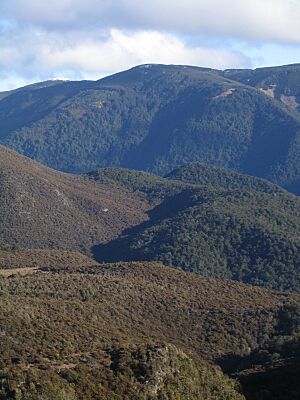
New Zealand's environment often experiences natural events. Native species have learned to live with these. Some are quick events like landslides, floods, El Niño weather patterns, and fires. Fires were rare before humans arrived. Longer-term events like huge volcanic eruptions and ice ages have also shaped where species live today.
Understanding New Zealand's Soil
New Zealand's soils are shaped by the rocks beneath them, the climate, the plants growing there, and how long they've been forming. In the central North Island, the volcanic rocks don't have enough important elements like cobalt for plants. But in the South Island, rare ultramafic rocks have so many needed elements they can be used as fertilizer! The warmer climate in Northland breaks down rocks faster, making deeper soils. In wet, steep places like Fiordland, landslides often happen. This means the soil doesn't have much time to fully develop.
New Zealand's Climate Zones
New Zealand's climate is mainly affected by three things: its mild latitude with westerly winds, being surrounded by ocean, and its mountains, especially the Southern Alps. Weather changes a lot across the country. It's extremely wet on the West Coast of the South Island. But it's almost semi-dry in Central Otago and the Mackenzie Basin. The far north (Northland) is subtropical. The hottest temperature recorded was 42.4°C in Rangiora. The coldest was -25.6°C in Ranfurly.
New Zealand's Ecosystems and Wildlife
New Zealand has many different ecosystems. Its plants and animals are very unusual because they were separated from other continents for so long. They share some links with the ancient supercontinent Gondwana. New Zealand broke away from Gondwana about 82 million years ago. Some plants and animals also have links to New Caledonia and Lord Howe Island, which are on the same plate. Others have links to Australia.
New Zealand has a rich mix of native and introduced plants. The native plants developed very differently because the country was so isolated before humans arrived. However, things like climate change, new invasive species, and more farming have caused a lot of damage. For example, New Zealand's forests are thought to be the second most endangered in the world. Only about 7% of their natural habitat is left.
Many of New Zealand's plants and animals are endemic. This means they are found nowhere else on Earth. Until recently, the islands had no native land mammals except for three types of bats. The main animals were insects and birds. Its plants are mostly from Gondwana, including famous giant kauri trees. Māori and European settlers brought many mammals. Some of these have become serious invasive species. New Zealand has a plan called the Biodiversity Action Strategy to protect its many threatened plants and animals.
Conservationists found that they could save threatened birds on offshore islands. Once harmful animals were removed from these islands, bird life grew strong again. About 30 bird species are now endangered. The flightless kiwi, which is a national symbol, is also at risk.
Forests of New Zealand
New Zealand's native forests are often called "the bush." They are mostly divided into temperate (broadleaf) and beech forests. Planted pine forests also cover a large part of the country. Very few native plants lose all their leaves in winter. Beech forests are common in high, cold areas. Temperate forests grow in warmer places. Temperate forests have more different kinds of plants, especially in the tree tops and undergrowth. New Zealand's forests are often called rainforests, especially in the very wet western areas.
Temperate forests change across the country. They prefer warmer places than beech forests. They are known for having many layers of trees. Near the coast, they grow smaller because of salt and strong winds.
Beech forests are divided into four types based on the main tree species. Their location depends on how high up they are. Black Beech forests are in the warmer lowlands of the North Island and northern South Island. Red Beech are in drier foothills. Silver Beech grow at similar heights but like wetter places. Mountain Beech are found high up near the tree line, which is below 1000 meters in New Zealand.
Beech trees don't flower every year. A year when they flower a lot is called a "mast year." When the whole forest flowers at once, it creates a lot of food. This causes a big increase in animals that can quickly use this food, like mice.
New Zealand's Grasslands
New Zealand has large natural tussock grasslands. These grow where high elevation and climate stop forests from growing. This includes the Central Plateau in the North Island. There are also large areas in the South Island between the tree line and the alpine (mountain) environment. Smaller tussock grasslands are found on flood plains. This is because the ground is always moving and there's a higher chance of frost. New Zealand's grasslands grew without grazing mammals. Birds (Moa) and insects were the main animals eating plants until sheep, goats, and deer were brought in during the 1800s. Different types of tussock grass grow at different heights and climates. The size of the tussock plants gets smaller as you go higher up the mountains. Tussock grasslands also help move water from higher areas to lower areas. This is because they don't lose as much water through their leaves.
New Zealand's Alpine Areas
New Zealand has two main ecosystems where cold and strong winds limit life. The Southern Alps were formed quite recently and are far from other mountain ranges. Because of this, New Zealand's plants and animals have quickly adapted to this new mountain environment. New Zealand's sub-antarctic islands are similar to the sub-alpine zone.
Rivers and Wetlands
New Zealand's lakes, rivers, and wetlands are the most threatened of its major ecosystems. Many coastal rivers have been dammed. Most of New Zealand's wetlands have been drained. Damming rivers can greatly change how much sediment is in the water and how fast the water flows.
Coastal Environments
Dune systems are always moving. Plants have adapted to live in this changing environment. Plants near the coast often grow small because of strong winds and salt. In the North Island, large mangrove forests have grown.
Marine Life

Including the areas where the land meets the sea, the marine (ocean) ecosystem is by far New Zealand's largest and most diverse. It stretches from warm subtropical waters to cold subantarctic waters, covering more than 30 degrees of latitude. Less than 1% of this huge area has been explored in detail. About 150 new species are discovered every year. The ocean environment has been greatly affected by fishing and the introduction of species from other places.
Rare Natural Ecosystems
Currently, there are 72 known rare land ecosystems in New Zealand. These are places that were always uncommon, like caves, serpentine soils (soil from a certain type of rock), or hot springs. There are also ecosystems that have become endangered. Some ecosystems are largely shaped by animal activity, such as areas with a lot of guano (bird droppings).
Human-Shaped Landscapes
Farmland and cities have many introduced species. These species haven't grown up together in the same ecosystem. These human-made landscapes can change the local climate. For example, the temperature in Christchurch is 2.5°C warmer because of the "urban heat island" effect. Also, farmland has less water loss from plants compared to forests. This means more water stays in the soil. Without the roots of trees to hold the soil, deforested areas are more likely to lose soil and have landslides.
Environmental Challenges in New Zealand
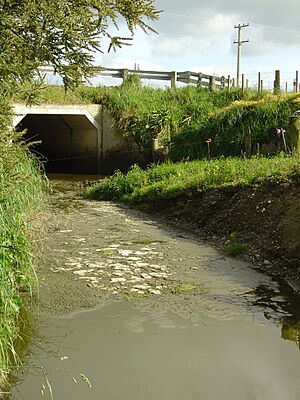

Like many countries, New Zealand has many environmental organisations working to solve different environmental issues.
The idea of using genetic engineering in New Zealand is opposed by some environmentalists. They worry about its effects on the economy and the environment. Now, releasing genetically modified organisms is strictly controlled by a law called the Hazardous Substances and New Organisms Act 1996.
Mining in New Zealand often faces opposition from environmental groups. Coal mining in the West Coast region is a concern. There are plans for new mines like the Cypress Mine and the Escarpment Mine Project. There are also issues at the long-standing Stockton Mine. Mining for Lignite (a type of coal) in the Southland region also faces opposition. Hydraulic fracturing (fracking) is another concern. A proposed soapstone mine in the Cobb Valley has also raised environmental worries.
Deforestation in New Zealand is less of a problem now. Logging native forests on public land has stopped. You need a permit to cut down native trees on private land. In the past 800 years, New Zealand has lost about 75% of its forests. This was due to fires started on purpose and clearing land for other uses.
The way waste in New Zealand is managed has become more controlled. This helps reduce environmental problems.
Water pollution in New Zealand is an ongoing issue. A 2009 study looked at 300 rivers and streams around the world. It found that the Manawatū River had the highest level of "gross primary production" (GPP). High GPP means the river isn't very healthy. It can lead to various environmental problems. Fish and Game, a government body, started a campaign called "dirty dairying." This highlighted water pollution caused by dairy farming. It led to an agreement in 2003 called the Dairying and Clean Streams Accord. This was a voluntary agreement between Fonterra (a dairy company), the Ministry for the Environment, the Ministry of Agriculture and Forestry, and local councils.
In 2011, the Parliamentary Commissioner for the Environment said that using 1080, a pesticide, was "effective and safe." The government and Federated Farmers (a farming group) say it's a good way to control possums over large areas. However, its use is still debated. Conservationists and farmers support it, while hunters and animal rights activists oppose it. People also worry about the safety of drinking water in areas where 1080 is used.
How New Zealand's Environment is Measured
Environmental Performance Index
The Environmental Performance Index (EPI) is a way to measure how well a country's environmental policies are working. It gives a score out of 100. In 2016, New Zealand scored 88 out of 100. It was ranked 11th out of 132 countries. In 2010, for freshwater quality, New Zealand scored 40.3 out of 100 for ecosystem health. It was ranked 43rd out of 132 countries.
OECD Environmental Review
In 2007, the Organisation for Economic Co-operation and Development (OECD) looked at New Zealand's environmental performance. Some of their main findings and suggestions were:
- New Zealand uses about the same amount of energy for its economy as the average OECD country.
- New Zealand uses less water, fertilizer, and pesticides than many OECD countries. However, during the review period, these uses increased. This put more pressure on the environment.
- New Zealand should make its national environmental policies stronger.
- New Zealand should include environmental concerns more in its economic decisions. This means using economic tools to make businesses pay for the environmental costs of their activities.
- New Zealand should work more with other countries on environmental issues.
New Zealand's Environment in Film
- Wild South series
- He Ao Wera – a documentary by Mike Smith and Hinekaa Mako about how climate change affects communities in New Zealand.
- Earth Whisperers/Papatuanuku – this Kathleen Gallagher film was shot around New Zealand. It shows 10 New Zealanders who believe that changing how we think can help heal our environment.



